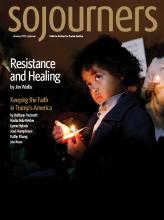ON ELECTION DAY, Pulitzer Prize-winning Washington Post reporter Mary Jordan suggested that we may need “a Reconciliation Commission, starting as soon as the results come in—no matter who wins.” In this troubling national moment, stories gleaned from historic truth and reconciliation processes can offer glimpses of hope and guide us forward.
A boy named Free Spirit was only 4 years old when he was wrenched away from his family and forced into a Canadian residential school. A nun gave him a new pair of shoes, which he plunged into a sink filled with water. He was shocked by the beating he received. His Algonquin people always soaked their new moccasins and chewed on them to soften the leather.
Decades later, during Canada’s 2011 Truth and Reconciliation hearings in Halifax, Nova Scotia, Free Spirit joined scores of witnesses who shared their stories of suffering in schools whose purpose was to annihilate their culture. Each evening, all the tissues used to capture the day’s tears were gathered and released into the Sacred Fire that burned outside. There they mingled with ashes that had been carried from previous hearings in other cities.
In the United States, the first large-scale truth and reconciliation process was launched in Greensboro, N.C., in 2005. Its focus was the 1979 Greensboro Massacre, in which members of the Ku Klux Klan and American Nazi Party opened fire on marchers demanding economic and racial justice, killing five and wounding 10.
As the hearings opened, Gorrell Pierce, who was the Grand Dragon of the Federated Knights of the KKK in 1979, strode in with a cadre of young white men. African-American community activist and pastor Nelson Johnson, who was wounded in the attack and lost five of his closest friends that day, immediately stood. He walked across the auditorium and made his way down that row of men, shaking every hand and thanking them for coming. Nelson admitted later that it wasn’t his first impulse, but that as a Christian he knew he needed to bring his best self to that encounter and try to reach out to the best self within Pierce.
Read the Full Article

